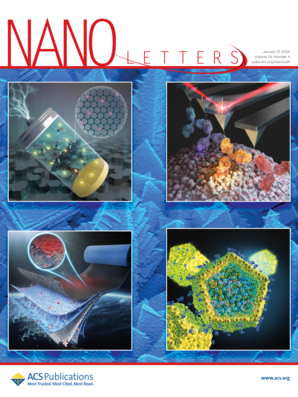Construction of Cation-Conducting and Anion-Capture Solid Electrolyte Interphase for Highly Stable Sodium Metal Batteries
IF 9.6
1区 材料科学
Q1 CHEMISTRY, MULTIDISCIPLINARY
引用次数: 0
Abstract
Sodium metal batteries are promising for grid-scale storage but suffer from dendrite growth due to anion-induced cation mobility limitations. To address this, we designed an artificial solid–electrolyte interphase (SEI) by grafting a fast Na+ ion conductor, Na5GdSi4O12, with oxygen vacancies (NGSO-Vo), onto a glass fiber (GF) separator. This unique structure combines fast Na+ conduction (8.55 mS cm–1) with anion immobilization, achieving a high Na+ transference number (0.9) in a conventional NaClO4/PC electrolyte. The NGSO-Vo-modified GF exhibits exceptional mechanical stability, effectively suppressing dendrite growth. As a result, Na||Na symmetric cells achieve an ultrahigh current density (30 mA cm–2) and long-term cycling (1500 h at 20 mA cm–2). Moreover, Na3V2(PO4)2F3||Na pouch cells with high mass loading (24 mg cm–2) demonstrate a record stability (4000 h). This work presents a simple yet universal strategy to enhance Na-metal battery durability, paving the way for practical energy storage applications.

高稳定钠金属电池中阳离子导电和阴离子俘获固体电解质界面的构建
钠金属电池有望用于电网规模的存储,但由于阴离子诱导的阳离子迁移限制而受到枝晶生长的影响。为了解决这个问题,我们设计了一种人工固体电解质界面(SEI),通过将快速Na+离子导体Na5GdSi4O12与氧空位(NGSO-Vo)接枝到玻璃纤维(GF)分离器上。这种独特的结构结合了快速Na+传导(8.55 mS cm-1)和阴离子固定化,在传统的NaClO4/PC电解质中实现了高Na+转移数(0.9)。ngso - vo改性GF具有优异的机械稳定性,能有效抑制枝晶生长。因此,Na||Na对称电池实现了超高电流密度(30 mA cm-2)和长期循环(在20 mA cm-2下1500小时)。此外,具有高质量负载(24 mg cm-2)的Na3V2(PO4)2F3||Na袋细胞表现出创纪录的稳定性(4000 h)。这项工作提出了一种简单而通用的策略来提高钠金属电池的耐用性,为实际的储能应用铺平了道路。
本文章由计算机程序翻译,如有差异,请以英文原文为准。
求助全文
约1分钟内获得全文
求助全文
来源期刊

Nano Letters
工程技术-材料科学:综合
CiteScore
16.80
自引率
2.80%
发文量
1182
审稿时长
1.4 months
期刊介绍:
Nano Letters serves as a dynamic platform for promptly disseminating original results in fundamental, applied, and emerging research across all facets of nanoscience and nanotechnology. A pivotal criterion for inclusion within Nano Letters is the convergence of at least two different areas or disciplines, ensuring a rich interdisciplinary scope. The journal is dedicated to fostering exploration in diverse areas, including:
- Experimental and theoretical findings on physical, chemical, and biological phenomena at the nanoscale
- Synthesis, characterization, and processing of organic, inorganic, polymer, and hybrid nanomaterials through physical, chemical, and biological methodologies
- Modeling and simulation of synthetic, assembly, and interaction processes
- Realization of integrated nanostructures and nano-engineered devices exhibiting advanced performance
- Applications of nanoscale materials in living and environmental systems
Nano Letters is committed to advancing and showcasing groundbreaking research that intersects various domains, fostering innovation and collaboration in the ever-evolving field of nanoscience and nanotechnology.
 求助内容:
求助内容: 应助结果提醒方式:
应助结果提醒方式:


